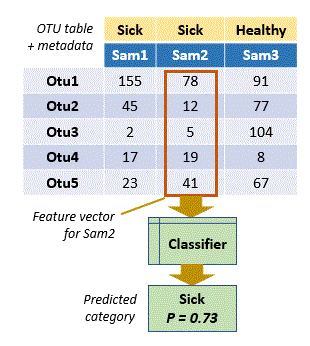Random forest classifier
 See also
See also
Machine learning in OTU analysis
otutab_forest_train command
forest_train command
forest_classify command
Wikipedia page
describing random forests
K-fold
cross-validation
OTU
importance
A random forest classifier is a
machine learning algorithm
for automatically predicting the category of an observation.
An observation is represented as a vector of numerical
values, one for each feature of the observation.
In OTU analysis, an observation is a sample, a feature is
an OTU, and the numerical value of the feature is the count or frequency of
the OTU in that sample. Thus, a feature vector is a vector of OTU counts or
frequencies for a sample. In this context, each column (sample) in an OTU table is a feature vector.
The category is an attribute of the sample, e.g. healthy
or sick, high or low acidity, etc. In microbiology, attributes are often
called "metadata", and a category (e.g. healthy) is called a "metadata
state".
The parameters of a classifier are trained on
observations (samples) which are labeled with the correct category. The
resulting classifier can then be used to predict categories of novel
samples. However, this approach is rarely used in practice in OTU analysis.
The most common use of machine learning classifiers in
OTU analysis is to answer the question: does the composition of the
community change with the sample metadata state (healthy / sick etc.)? Put
another way, can metadata states be predicted from OTU counts or
frequencies? Random forests are an effective way to address this question
because they are very flexible and robust. For example, unlike most other
classifier algorithms, they are highly tolerant of many uninformative features
(i.e., OTUs which do not correlate with sample attributes), and make few assumptions about the structure of the data.
Random forests are based on discovering rules which are
constructed from Boolean expressions with fixed numerical thresholds for the
counts or frequencies of given OTUs. For example:
Sample is "Healthy" if (OTU64 has count>100 and OTU12
has count<10) or (OTU4 has count=0).
Sample is "Sick" if
(OTU10 has count>1 and OTU11 has count>1 and OTU15 has count>2).
Important OTUs, i.e.
those which are predictive of metadata states (i.e., are used most often in
the rules discovered by the classifier) can be identified in the
forest parameter file.
I usually don't recommend trying to identity informative
OTUs by training a random forest on the complete OTU table as this may tend
to over-tune the parameters. It is better to use k-fold
cross-validation. Usually, OTUs are informative because
their abundances correlate with metadata state, e.g. an OTU frequency might
be tend to be high in a sick person and low in a healthy person. It is simpler and
more direct to use the otutab_select
command to identify those OTUs. Comparing results from otutab_forest_kfold
and otutab_select is useful to check whether the rules discovered by the
random forest are mostly simple correlations (these OTUs will be identified
by otutab_select) or have more complex associations (which will not be
discovered by otutab_select).
Reference
L. Breiman (2001)
Random Forests, Machine Learning. 45 (1): 5-32. doi:10.1023/A:1010933404324




 See also
See also